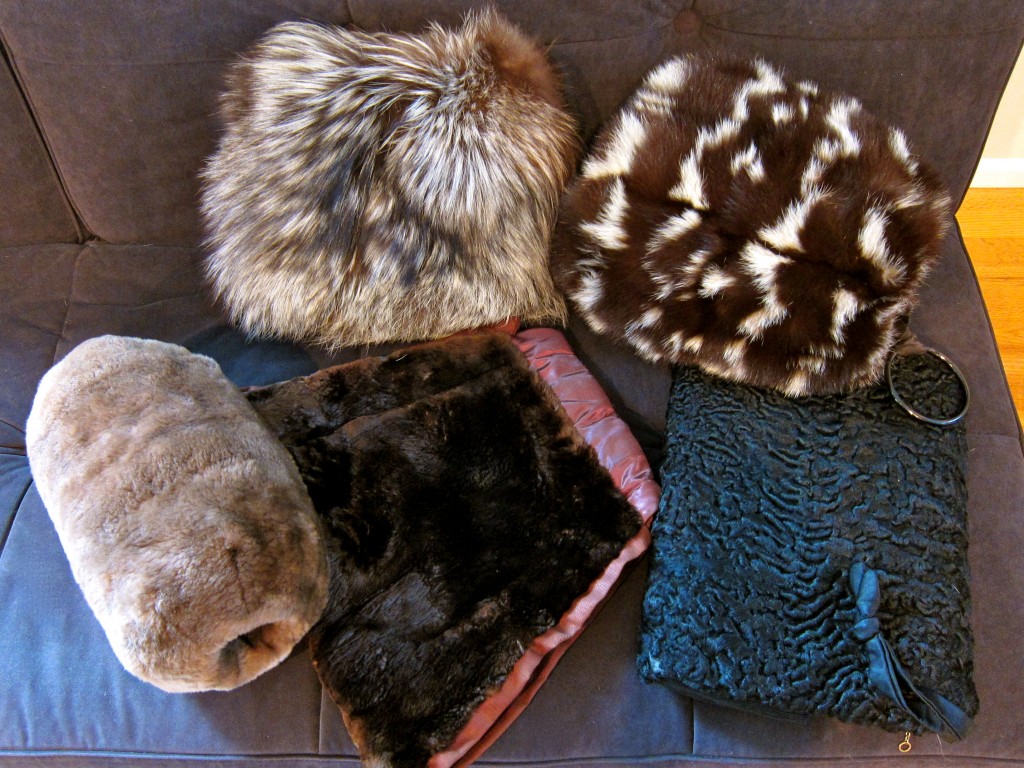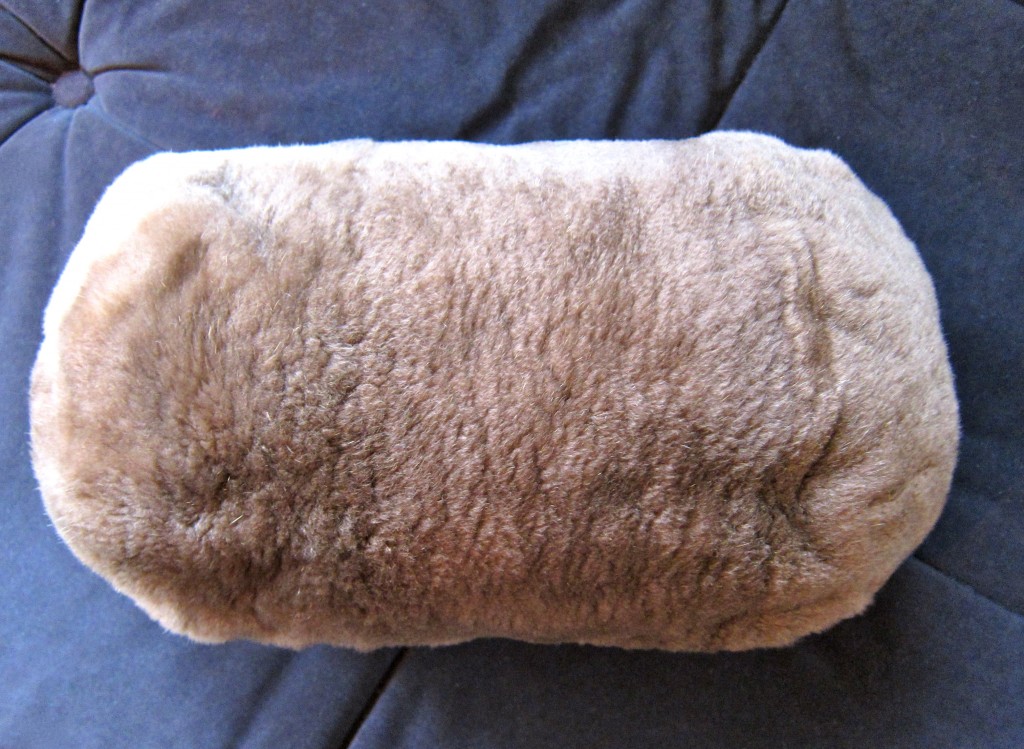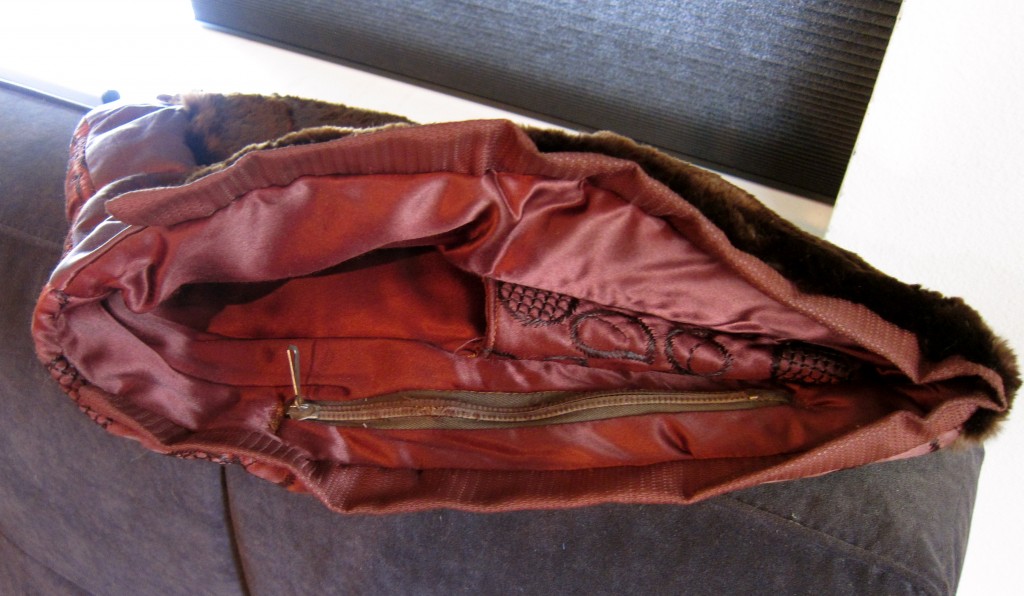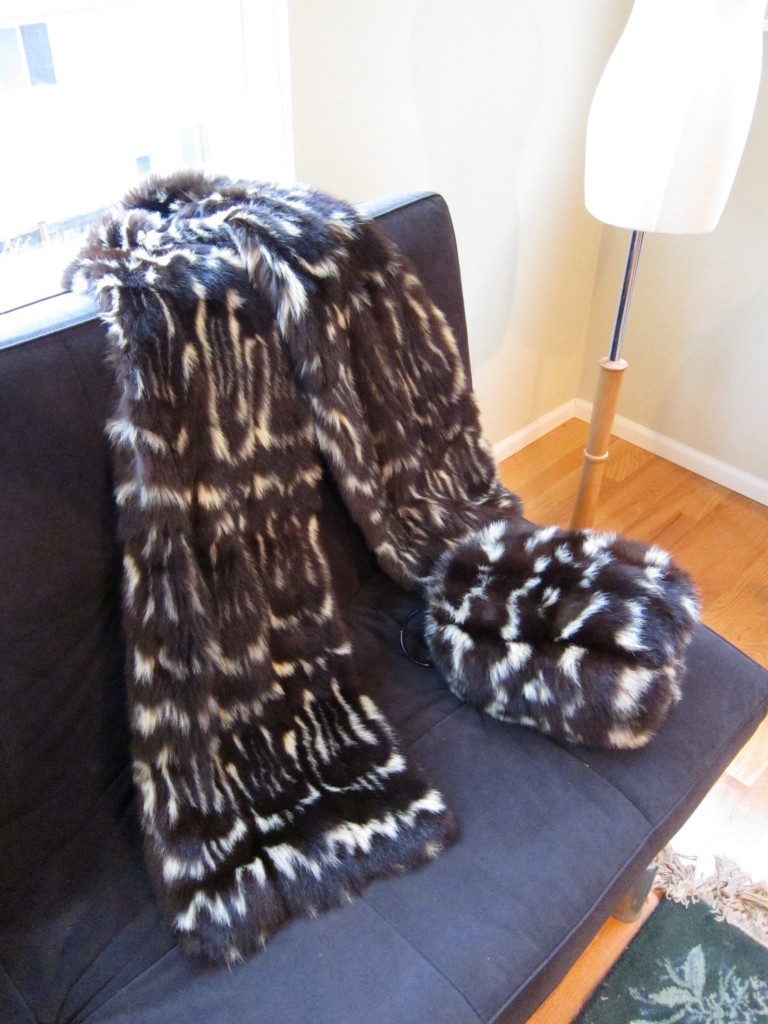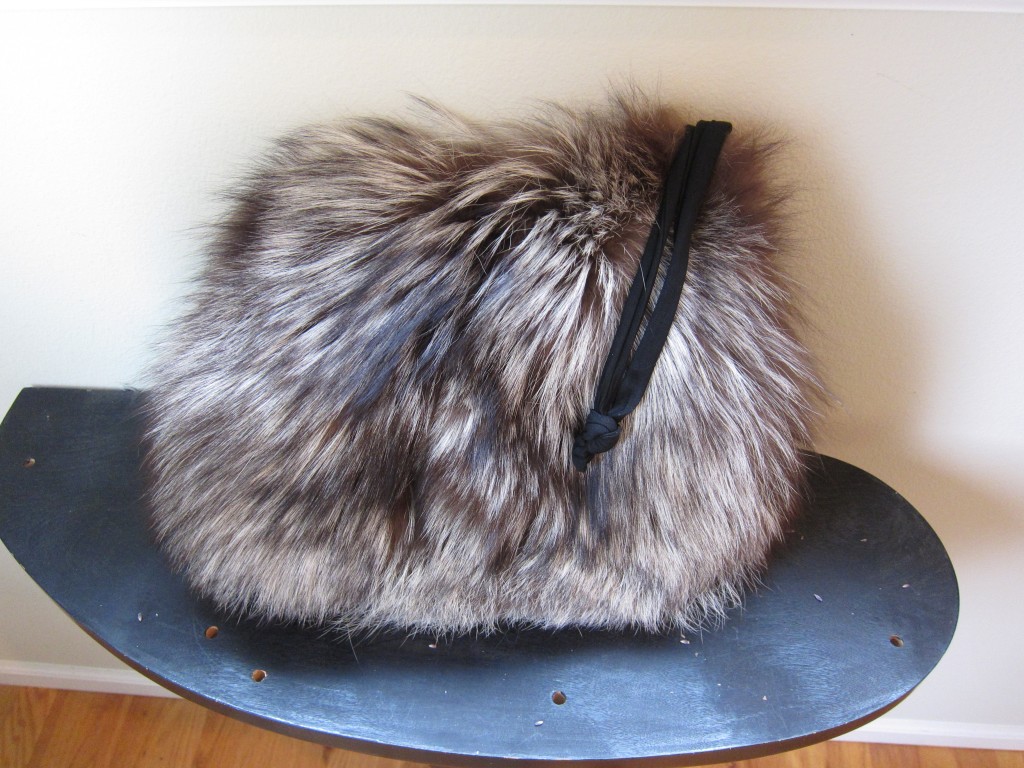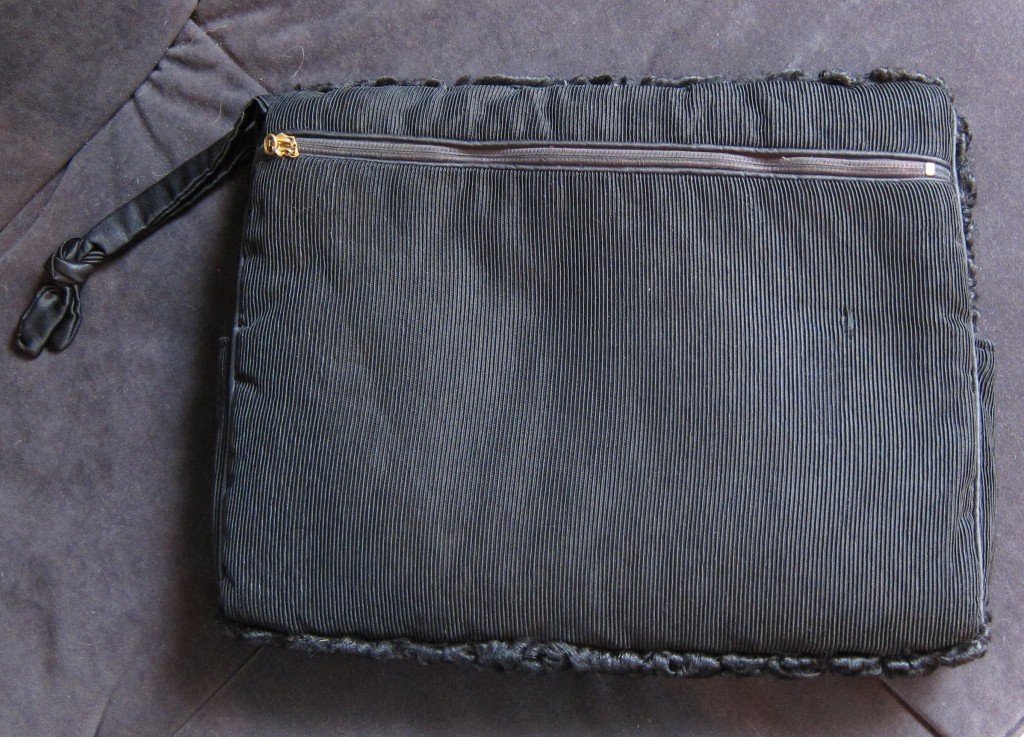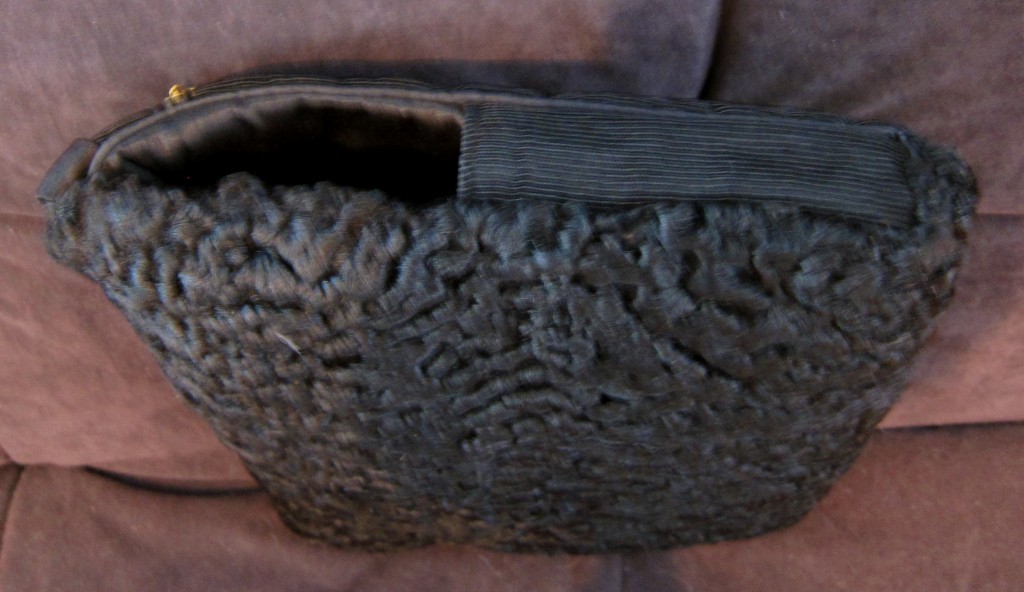I have a small collection of vintage fur muffs. Several of them are also purses. I absolutely love muffs. They are so practical and darling! You can carry them instead of a purse and have a place to keep your hands toasty warm while looking glamorous or romantic.
The first one I acquired is the beaver one which was my grandmothers when she was a young woman. It is natural brown colored sheared beaver and very soft. There is a zipper in the back which opens to reveal a roomy satin lined “pocket” compartment which serves as a purse for carrying a few essentials. It has a loop made of heavy satin ribbon to attach the muff to your wrist. My grandmother told me she used it wherever she went in the winter and, most romantically on sleigh rides and when she went ice skating on a lake near their home where the young people gathered for winter socializing and recreation. It is very soft and silky and exceptionally warm. The part of the fur we see in this muff is the part that is located under the stiffer and longer guard hairs that you see on a live beavers coat. They shear off the guard hairs which protect this inner part of the beaver’s coat when processing the fur in this manner. This softest thick part of the coat, under his guard hairs, is what keeps him toasty warm in bitter winter cold and serves as his insulation while he is swimming and working in snow and icy water. His longer outer guard hairs literally serve to guard this amazingly soft and warm inner coat. Water runs right off the guard hairs and when swimming they make him sleeker and faster in the water. Beaver fur is used for garments both with the guard hairs left on it and sheared in the manner of this muff. With the guard hairs on the fur has a courser feel when you stroke it, but this super soft exact part of the fur is located right under the guard hairs next to the leather skin. Snow will slide or shake right off a beaver coat with the guard hairs on it while this inner fur is keeping the wearer, or the beaver, exquisitely warm. A sheared beaver coat is more dressy and elegantly soft and was usually made for garments to be worn for fancier occasions.
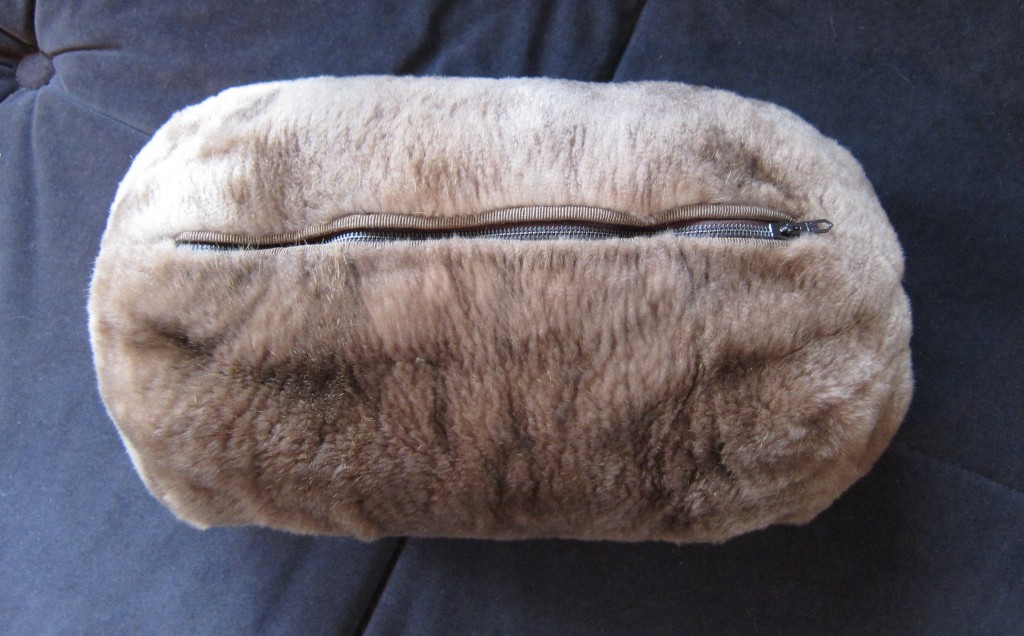
This is the Backside of the Sheared Natural Brown Beaver Muff Showing the Zipper that Gives Access Into The Satin Lined Purse Compartment discreetly Hidden Inside The Muff!
Fortunately my grandma took very good care of her sheared treasured beaver fur muff and she gave it to me when I was in the 4th grade doing a school science report on beavers. I lived in Portland OR at the time and every child had to pick a topic for a science project. I chose the beaver who happened, coincidentally to be the official state animal! Of course my topic was approved by the teacher! I did not pick the beaver because he was the state mascot. I picked him because I loved my grandma’s beaver fur muff and my grandpa’s stories about real beaver damns he had observed. They loved beavers and I developed a great affection for them hearing them talk about them. My entire family got involved in helping me and I wrote a spectacular report with great displays which included this very beaver muff! My father took me to visit a professional furrier in downtown Portland who gave me strips of beaver fur to use for my displays. I had a sample with the guard hairs still on it, one that was sheared like this muff, and several that were dyed different colors to show some of the ways the furriers could create different colors and looks with the same type of fur. I had a white one, several shades of brown, a tan one and a black one.
My rancher woodsman grandfather took me out into the wilds of Idaho to observe a beaver damn and the large beaver colony in action. It was amazing and I will never forget it. We ever so carefully chopped down a stump from a tree that a beaver had felled and mounted it on a wood display block for me to show in my report. My grandpa just happened to have a real set of beaver front teeth in his collection of weird treasures that I was also allowed to use in my display as well! They were long and very stained and sharp and you could see how they were ideal for cutting down entire trees and chewing through logs to make them a usable size in damn building. We displayed these next to the mounted tree stump in a special cigar box with a glass lid mounted in the top!
After the trip to observe the damn, which was quite an excursion, as we packed into the mountains on horseback and camped out for 3 days and nights in order to study them, we constructed a reproduction of the entire beaver colony and damn in a diorama using sticks and mud and moss and stones and other things. We made it small enough to transport and show on top of a table. My grandfather was so excited and willing to help me that we even created a cutaway of the damn to show what it was like inside!
To top things off we displayed his beaver felt hat from the days in which he courted my grandmother, pictures of them in hat and muff and her fashionable brown beaver fur jacket. I do not have those items now. Other family members do! They are in another state so I cannot get pictures to add to this post right now! Sorry!
My report on the beavers was a big success. It was success that I ended up winning the first prize in the state for my Science report. I am sure that the fact beavers were the state animal and are featured pictured on the Oregon state flag helped me win. I was taken to many schools to present my report in person. I sure wish someone had filmed or video taped it! But nobody did that in those days so it is only a legend now! Finally the entire display was featured at OMSI ~ the Oregon Museum of Science and Industry in a display with plaques and everything for several years. I was really impressed by the plaques and having my name on them when I was in 4th grade! My family moved from Portland to Seattle a year later and I have no idea what became of my beaver exhibit and report after that.
The conclusion to the story is that I have had tremendous respect for beavers and have truly loved the little guys ever since! I now live in Lynnwood, WA and a couple of years ago an industrious beaver colony built a large damn in a wetlands area just off the 44th Street Exit of Interstate 5. That is the exit I take to get to my house! They quickly built a big damn and it caused a lot of water backup leading to a flood that forced the highway department to close off the roads. The industrious beavers were so adept at building and so determined to succeed that they could not be stopped. ( I really enjoyed watching this transpire!) At first the highway maintenance people tried to redirect them a bit without disturbing them, but it didn’t work! More beaver troops were called in for this emergency project, arrived from somewhere, mysteriously, and built the damn bigger and higher in record time working 247 around the clock in the freezing dead cold of damp and icy winter! The lake, (Yes! Really! It became a large lake! ) completely blocked off that freeway exit and several blocks in each direction. No one could get through. something had to be done!
The State Wildlife Department organized a swat operation and came in and captured all these beavers and transported the entire group to a new distant location suited to their lifestyle but far from civilization as we know it! I do not know where they are now, but I hope they have adapted and survived. Every time I pass the wetlands I think about them and I miss them! Of course I think they should be protected. When I use my sheared beaver fur muff I get to tell people what it is and I get to tell my fantastic true story about my 4th grade beaver report. And I get to urge people to protect the existing beaver colonies. This is a perfect opportunity for me to promote the protection of this beautiful animal and I think the muff is doing more good for beaver society that it would if it were destroyed. as the Peta people advocate doing. I have strong personal opinions about this and I feel you can make people care more about issues like animal protection through education and knowledge of the history of the animal and its relationship to people during the development of our society. In our history the quest for beaver pelts was why much of Canada and the western states were explored, settled and developed. Now it is our turn to protect them.
Today I am writing about my muff collection, but, soon I will photograph and post pictures of the 1947 wool cloth coat trimmed in a different kind of fur collar that my grandmother wore with this sheared beaver muff. I will show how the two kinds of fur coordinate with each other really well and can be worn together now, just as she did back then for an elegant put together look. The coat is currently being cleaned and having a button restored so I cannot include it for a few days. I will link the two posts together when I put it up.
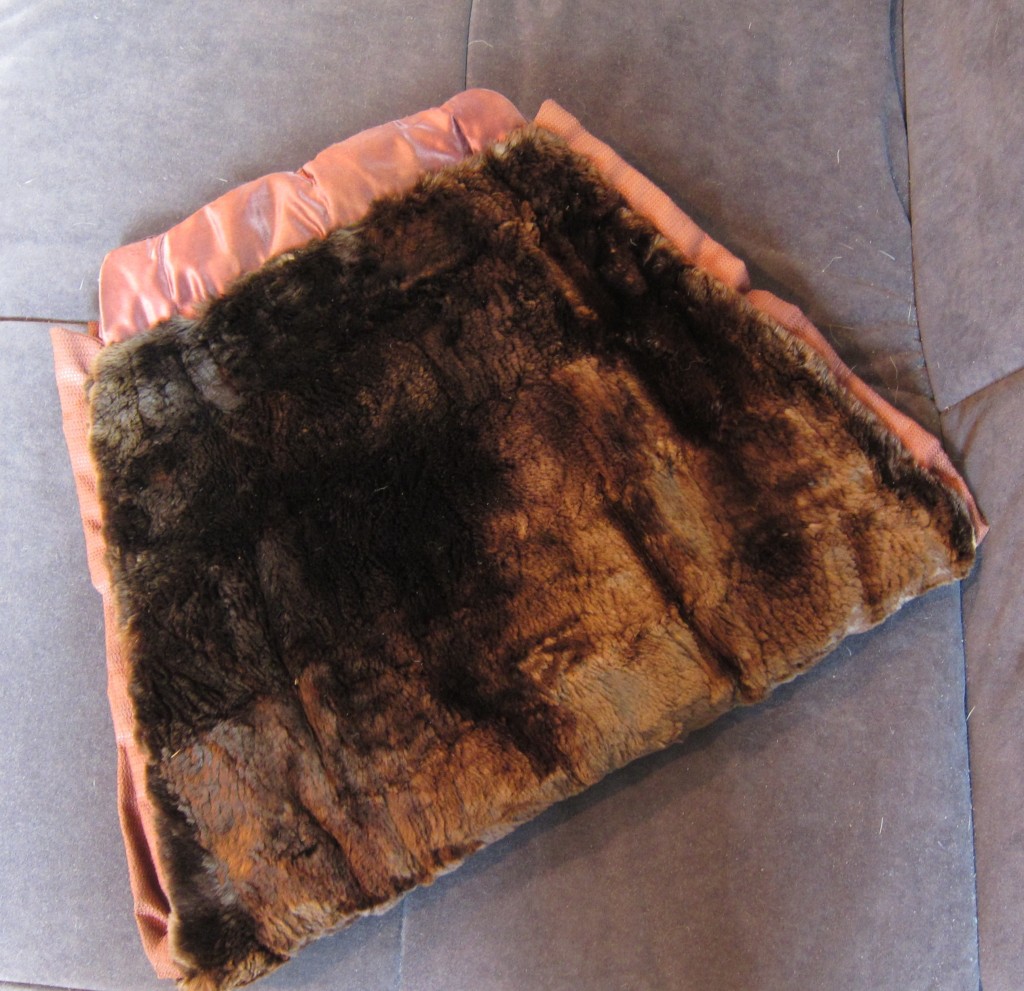
Amazingly Soft Sheared Seal as Used in This Muff is Even Softer and Finer Than Exquisitely Soft sheared Beaver!
Most furs have guard hairs to begin with and many can be sheared off to get down to the softest part of the fur which can then be used for elegant garments and fur accessories such as muffs. a sheared fur garment is more delicate than one with the guard hairs left on to continue to guard the fur. This should be rather obvious! The reason some people get confused by two items made of beaver or other fur is that one could be sheared and one could still have the guard hairs on it and they could very legitimately look quite a bit different to the untrained or inexperience eye. Furs can be bleached or dyed different colors or shades as well, just like human hair, so that could change the look as well! It is no wonder people who are new to fur get confused at times! Additionally, designers and furriers have been very creative over the years and have made furs and garments having unusual effects that become difficult to recognize without experience. The more you see, feel, study and collect, the better you will become at correctly identifying fur types. That is why I am writing these posts and showing pictures of my own furs ~ in order to share what I have learned and help others figure out what they have. I hope it is helpful.
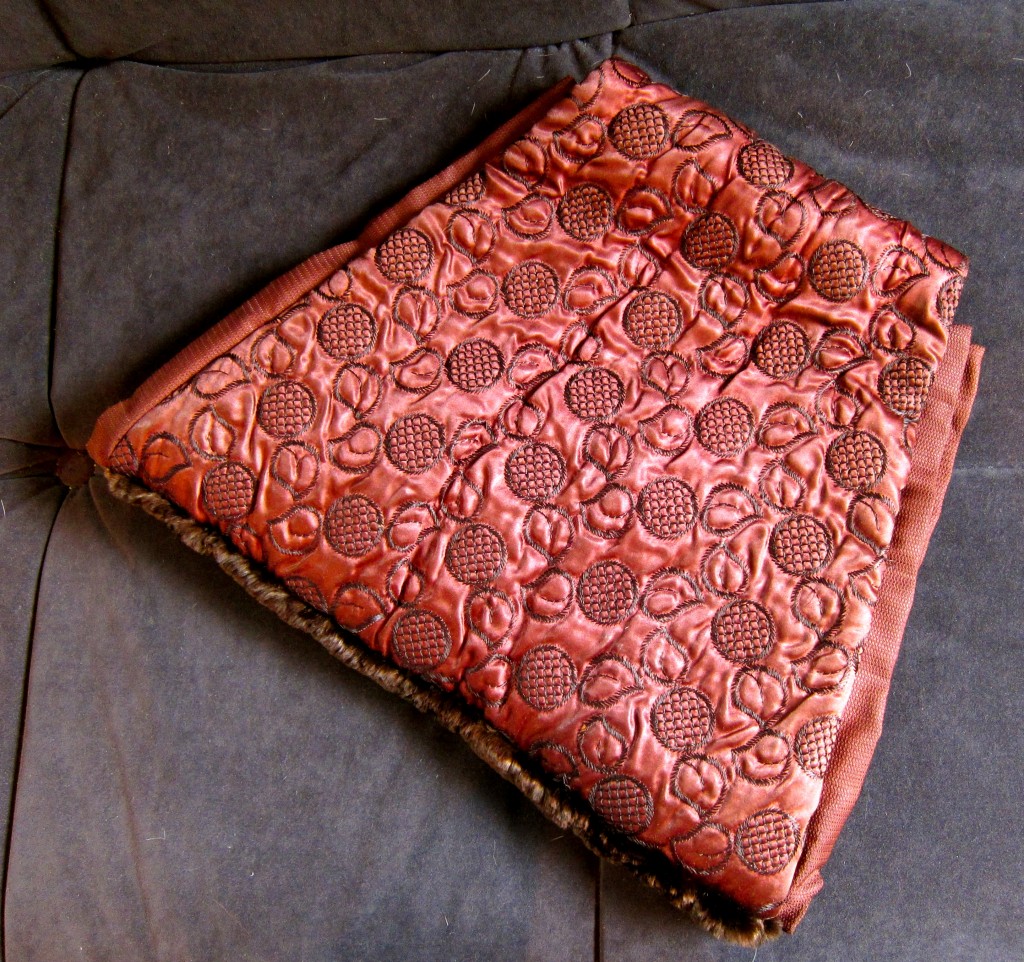 This Photo Shows The Back Quilted Silk Satin Side of the Sheared Seal Muff. It is Feather Down Filled for Extra Warmth and Elegance. This Piece Dates to 1912
This Photo Shows The Back Quilted Silk Satin Side of the Sheared Seal Muff. It is Feather Down Filled for Extra Warmth and Elegance. This Piece Dates to 1912
This muff is made of sheared seal on the front side and quilted silk satin filled with feather down on the back side. it is also lined with silk and filled with feather down on the fur side. I love the color of the silk satin and the decorative stitching pattern used in the quilting stitches. there is a small piped border on each side where you put your hands into the openings. In the next picture I have turned the muff sideways to try to photograph the inside and show the zippered interior purse compartment.
When you turn the fur side in the light you get different effects of coloration depending on how the light hits the pile of the fur. The entire piece is beautifully constructed.
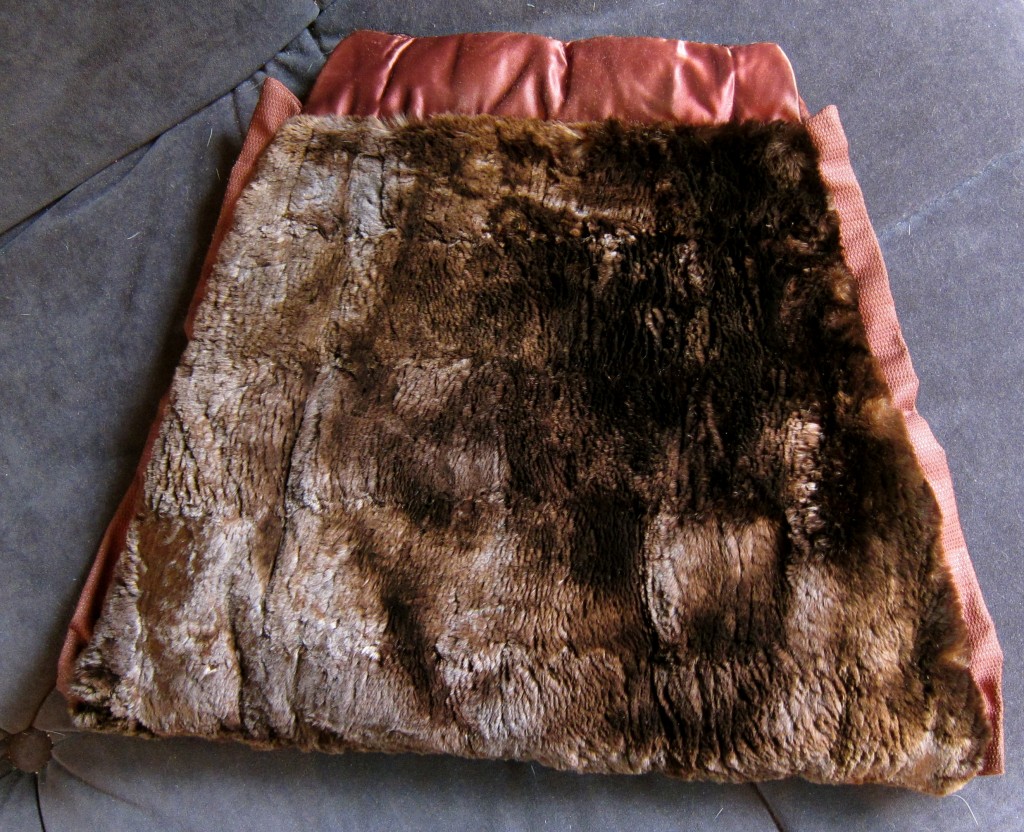
The Seal Fur Can Be Stroked to Lie in Different Directions Which Gives a Different Effect and Look to the Fur Color
In the next picture I have photographed again in natural light but the color looks different ` a bit cooler, because of the quality of the light hitting the fur. You can change the way the fur lies by stroking it one way or the other. I love to “pet” the muffs when I am using them! You should never brush your furs or comb them. It will damage them. You can smooth them out with your hands gently. Be sure your hands are clean and dry and free of any hand lotion, cosmetics or perfumes as they could damage the furs. If you want to wear perfume you should apply it to your own skin in areas where it will not come into contact with the fur itself.
Please note. I took all the pictures of these muff at the same time. The color fluctuates a lot on this seal one but this is due to the way the nap of the fur is positioned, turning the fur muff, or moving it a bit into a different quality of light.
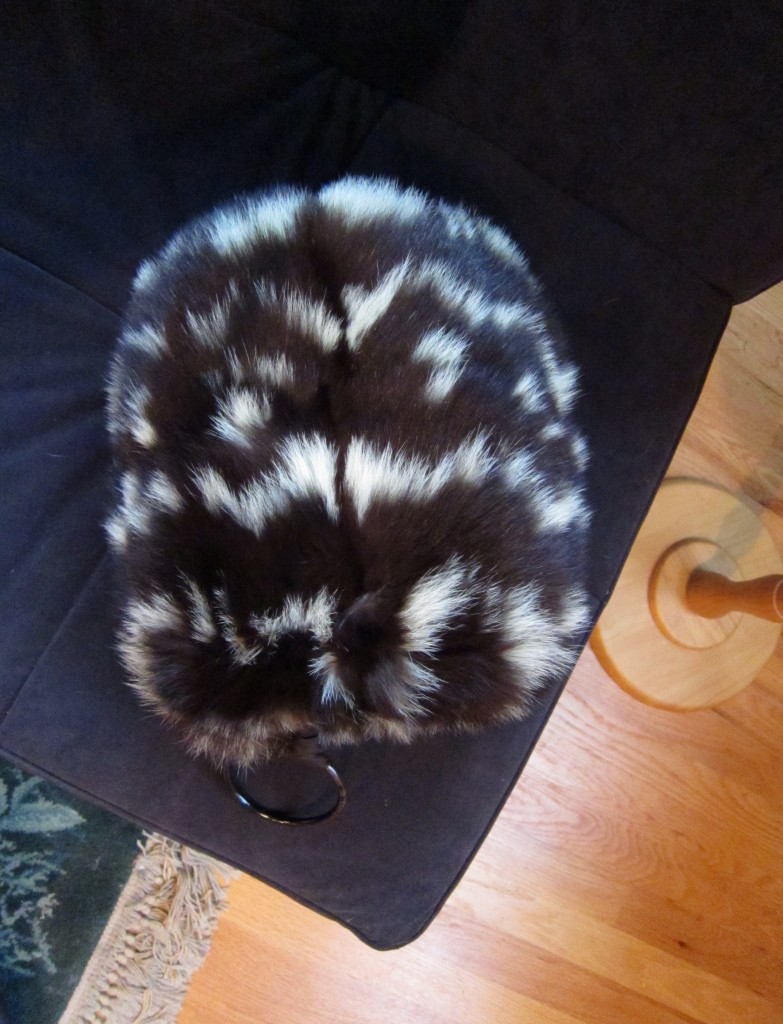
Dramatic Natural Black/ Brown and White Natural Skunk Vintage 1940s Era Muff with Bakelite Wrist Ring Attached
This vintage 1940s’s muff is natural black/ brown skunk fur which is kind of obvious isn’t it? I am saying that with a sense of humor because I have been asked if it is some really odd things ~ ranging from dog to zebra! I do not think it looks like those animals at all and I think it loos exactly like a skunk, so I can only assume that the people who say such things must not know their animals or look at animals or pictures of them very care fully!
This skunk muff is not a purse but it does come with a matching stole! The muff is made up of six skunk pelts and the stole is made up of 24 skunk pelts! I have written extensively about the skunks fur and how to recognize it in my previous post on this skunk ensemble * . Sometimes skunk is dyed jet black.
This incredibly fluffy long haired vintage muff purse is Silver Fox Fur. It is only fur on the font side and is backed with black textured fabric. It has a black satin wrist strap. It is uniquely designed to have two compartments for your hands, one for each hand. There are several kinds of natural foxes and they are different natural colors – not dyed. Sometimes fox fur is dyed as well. In the future I will show you different kinds of natural fox fur in different colors so you can see the differences, but in thins post I am focusing on muffs so I want to be sure it is understood that this particular example is a Silver Fox. This has been confirmed by a professional furrier, Rene Vogel.
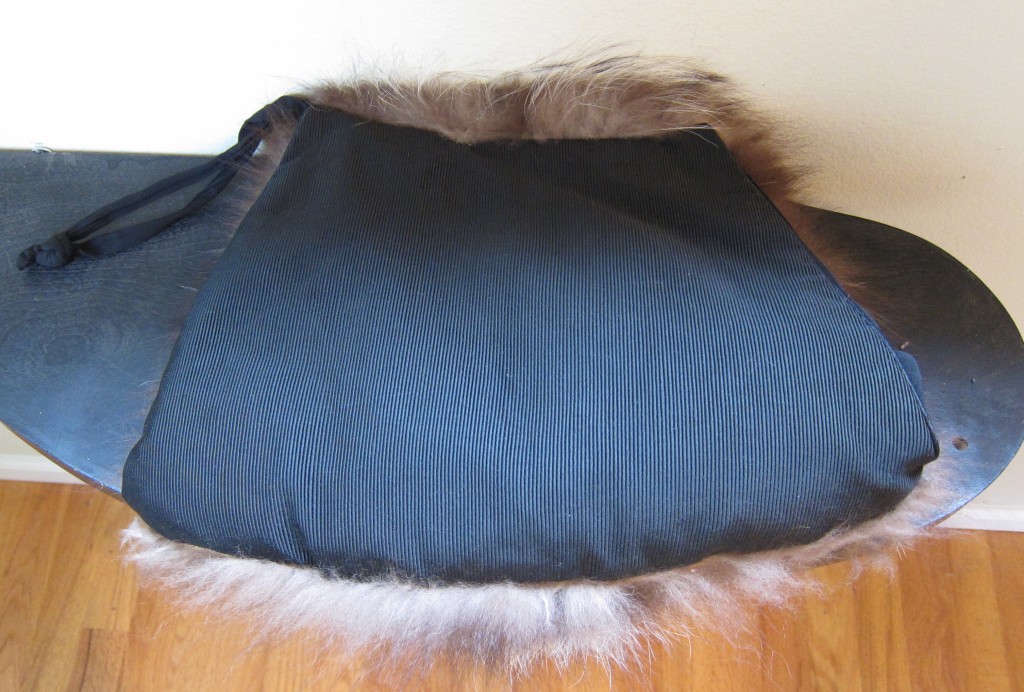
This Picture Shows the Black Stripe Textured Fabric Used to Back the Fur Portion of the Silver For Fur Muff Purse.
Inside this Silver Fox fur muff purse has a concealed secret zippered purse area for your belongings. I love how well structured it is. The old time furriers did a nice job of designing and sewing these muff purses. The muff keeps your hand so cozy and warm as well. I personally need this extra warmth even when I am wearing gloves! I love the idea and the practice of keeping warm with fur lined gloves in a fur lined muff while wearing a fur lined coat and a fur hat and fur lined boots. I have tried every other solution to keeping warm but none other works as well. I am thin, I have no body fat to help me stay warm! I have become aware of how tiny a fox is inside his fluffy long fur coat insulated for the winter cold by his beautiful fur pelts.
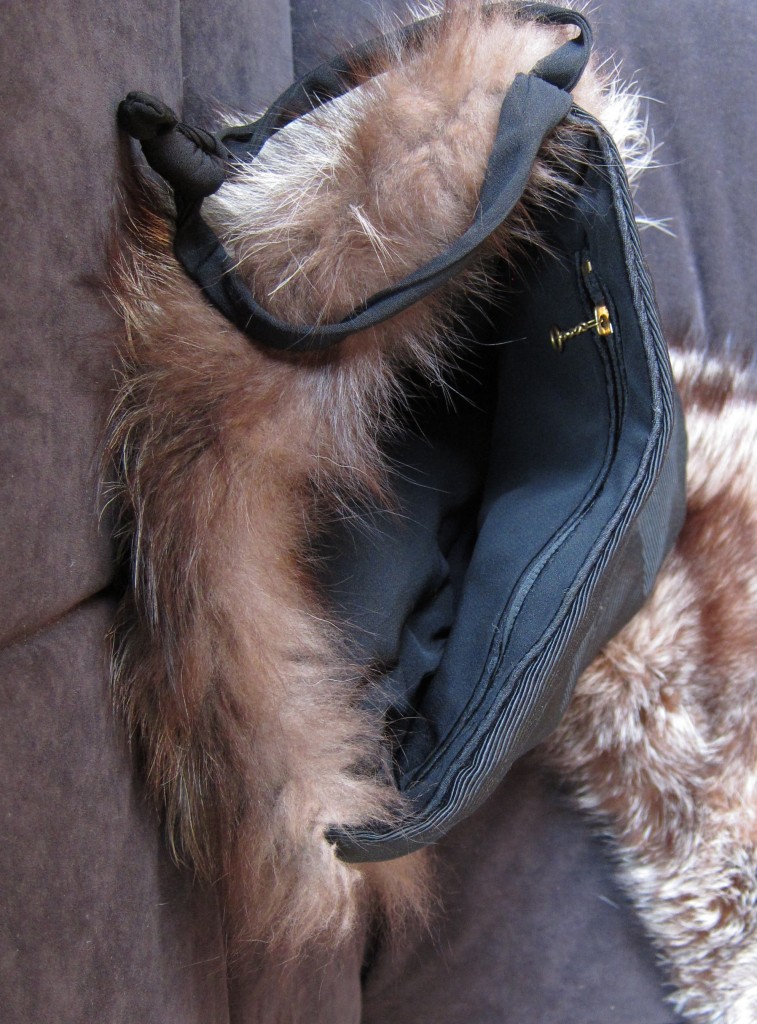
I Have Tipped the Fox Muff Purse at a Weird Angle So I Can See Inside It To Photograph the Zipper for the Purse Section
The furs are lightweight, they trap air between then to keep you warm, some fur follicles are hollow and these trap additional air within the individual fur hair itself to keep the animal even warmer or the human wearer of the coat made of his fur even warmer. This is why, in olden times, when there really were not many ways to keep warm people initially wanted to wear furs from animals for coats. It was the only way you could keep from freezing to death in some bleak and frozen places. Historically humans began to wear furs as a necessity for their own survival. I do not think that a lot of people who work for animal rights realize this or, if they do, they never think deeply about it. As humans we owe a great deal in our evolution to the fact that we had animals to eat and their furs to wear in order to keep warm and thus stay alive! Personally I am very grateful to animals of the past for making this contribution to the survival of my species. When I wear a vintage fur or carry a vintage fur muff purse I an sometimes able to use the comments people make about wearing furs to discuss this. I find it very wasteful of a life to discard a perfectly useful vintage fur when it still has a lot of useful life in it! I personally want to honor the animal from whom the item came by wearing his already dead pelt proudly until it expires naturally.
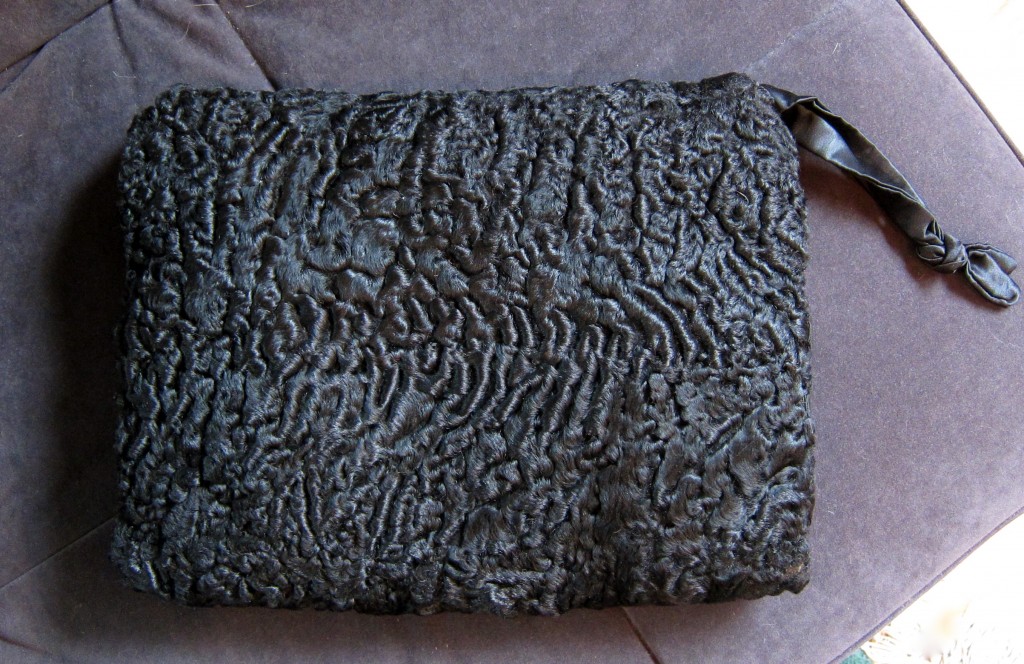
Natural Black Persian Lamp Fur Muff Purse with Black Fabric Backing and Satin Wrist Strap Made in the 1950s
The last vintage muff purse in my collection is natural black Persian Lamb fur. It features very curly black fur on its natural black skin backing on the front side. The back side is a heavy black brocade like fabric. This muff is the real thing. Faux versians of Persian Lamb exist as well and were often used for coats and jackets in the 1950s. I will do a post on Persian Lamb in the near future explaining how to tell the difference and showing examples. I have decided to save that topic for another post because it will make this one really long if I add it now!
Sewn into the black fabric back in a metal zipper to access a generous pocket which is the purse. In the next photograph I will show the zipper pocket unzipped and shot from above so that you can see inside the purse. It is a really roomy compartment.
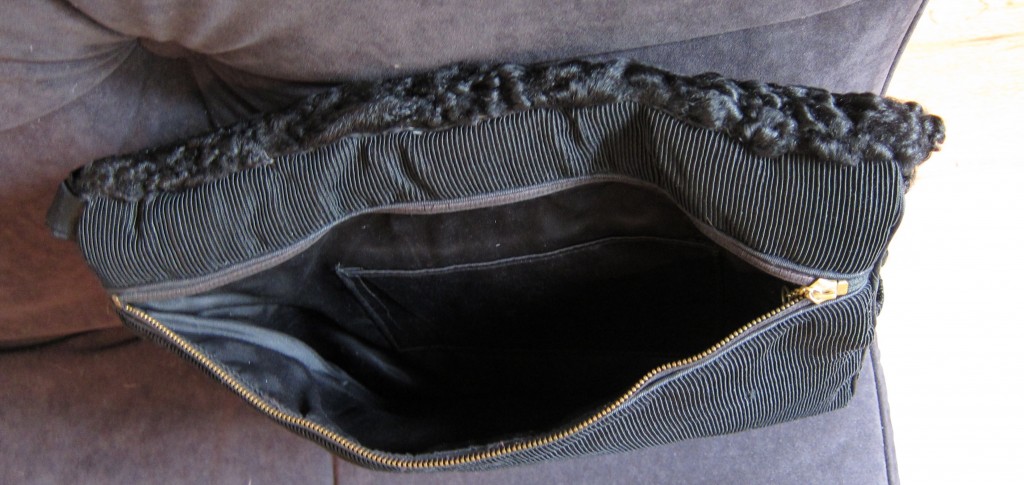
In This Photo You Can Look Into the Unzipped Pocket Section of the of the Black Persian Lamp Muff Purse and See How Nice and Roomy it is! It even has another little pocket inside of it that is meant to hold a small mirror!
Then I will show the muff purse standing on one end so you can see how it was structured.The openings at the sides of the top were where you inserted your hands to keep them warm and they are positioned so that you insert one of your hands through the wrist strap first, then a hand each into the top section openings of either side of the muff. The muff then hangs in front of your body in a perfectly balanced manner.
Marilyn Monroe carried a muff purse like this one, also in Persian Lamb fur as she ran to catch the train in a black hobble skirted dress in the movie Some Like it Hot! One of the nice things about muffs is that they give you a place to put your hands. This can be a real asset when posing for photographs or in Marilyn Monroe’s case acting in a film! It is a valuable tidbit of knowledge at any rate! Who knows when any of us might be called upon to play a femme fatale?
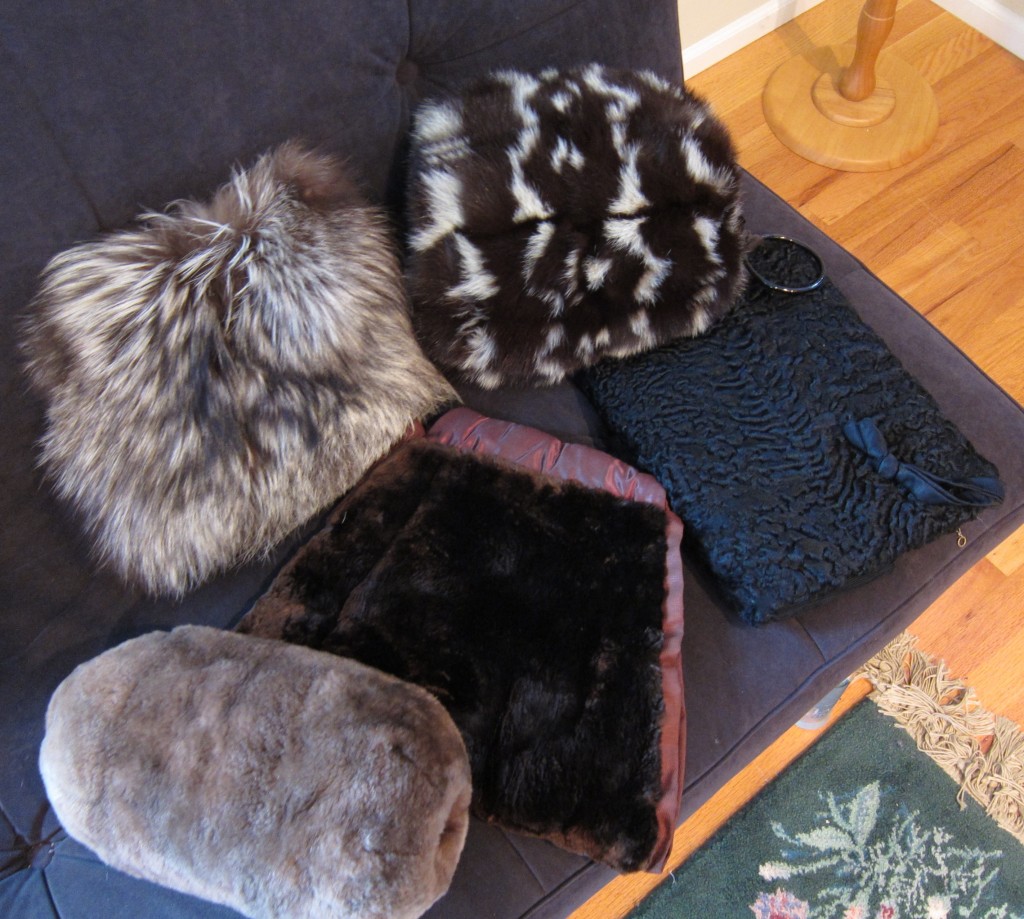
My Vintage Real Fur Muff & Purse Collection Comprised From Lower left Corner Clockwise of: Sheared Beaver, Silver Fox, Skunk, Persian Lamb and Sheared Seal
The reason I have shown so many photos and various angles of these muff purses is to document and illustrate some of the ways in which they are constructed. Some are just cylinders drawn together at each hand end while others are rather complex designs. I think there are vintage patterns available to make some muffs and muff purses. You could make them out of fur or faux fur or possibly heavy wool or novelty fabrics such as upholstery fabrics and line them and fill them with down to make them warm. I love fur ones the most but I think interesting ones could be made with alternative materials. I think of them as purses as well as hand warmers so there are undoubtedly some unique variations to be made. I have also seen old crochet patterns for making muffs and matching hats! I believe I have one somewhere in my book case. I will try to find it soon and post it here on my blog so we can look into more ways to make vintage muffs!
I plan to do another photo shoot soon showing ways to wear these beautiful muffs with vintage and contemporary clothing. If you have fur muffs and want to contribute photos to me to add to this post I would be interested in doing so. You can leave a comment about this in the comment section with your email address and I will get back to you about it. I am also interested in locating and preserving more vintage for muffs made of different kinds of fur and in different styles. If you have fur muffs you are interested in having used for this project please contact me. My email address is violette@ladyviolette.com.
In my interest of being absolutely sure of what kinds of fur I have and claim these to be all of these vintage fur muffs have all been inspected and authenticated in October 2012 by a professional Swiss custom furrier in Seattle, WA named Rene Vogel of Furs by Rene. Thank You Rene!
f
